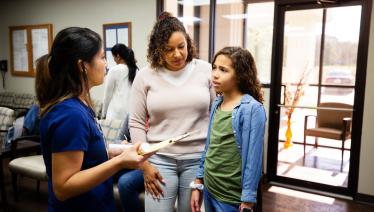Working with middle and high school English Language Learners (ELLs) presents a unique set of opportunities, benefits, and challenges. In order to achieve the highest level of success in the classroom, it's important to acknowledge these factors and understand how they affect student learning.
Even with great instruction, success in the classroom will become that much more difficult to achieve if the social and emotional needs of a student are not met. This is especially true for middle and high school ELLs, who often have significant responsibilities at home.
This article will provide an overview to how you can support the social-emotional well-being of your students with practical strategies. Educator voices from around the country are also featured in the related videos.
You can learn about teaching this age group from the other articles in this series:
Getting to Know Your Students
Why relationships matter
The better you know your students, the more effective your work with ELLs will be. Building relationships with students can help:
- increase student confidence
- provide meaningful connections to students' interests and experiences
- inform your instruction and support.
Your role: Look for ways to get to know your students and build relationships, and stay attuned to clues about their schedules and responsibilities outside of school. Look for opportunities to interact informally before or after school, at lunch, during advisory periods, or through extra-curricular activities. Advisory periods can also be a good time to check in with students on classwork, their credits, or updates on how they are doing.
Video: Getting to know my students
Video: How advisory periods are helping my students
Video: Why building relationships with ELLs matters
Learning about students' prior experiences
While it's important not to ask too many questions of students right away, learning more about their past experiences can help give you some important information. For example, many ELLs are part of unique populations of students who might have shared some similar experiences, including:
- refugee students
- migrant farmworkers
- unaccompanied children
- Indigenous students
- students in mixed-immigration-status households
- internationally adopted students
- students with interrupted formal education.
Learning about these special populations can give you context for students' experiences as you get to know their own unique circumstances and stories. It can also alert you to the possibility of trauma. If students may need additional mental health support, consult with family liaisons and mental health professionals at your school to identify possible resources and services that might be appropriate.
Video: Why an Indigenous student hid his background
Video:A long journey on a cattle raft
Family Responsibilities
Impacts of COVID-19
Learn how COVID-19 pandemic has affected ELL/immigrant families from the following:
Many ELLs at this age are responsible for much more than the average teenager, and have a complex set of transitions and concerns to face — even moreso now due to the COVID-19 pandemic. During the pandemic, it was not uncommon for teachers of older ELLs to receive assignments in the middle of the night after students finished working a late shift or got their siblings to bed.
In addition, many students in immigrant families may have significant responsibilities, especially if a family member, parent, or caregiver is not yet in this country or has been deported/detained. You can learn more about supporting the social-emotional needs of immigrant students from our related resource guide.
Financial responsibilities
Some students contribute to the family's financial needs by working outside the home. They may work all weekday evenings and on weekends.
Household responsibilities
Other students care for younger siblings while their parents go to work. Cooking dinner for the entire family and cleaning the house are common tasks for students when they get home. All of this — and they have to complete their homework too.
Translation responsibilities
Your ELLs may be the most proficient English speaker in their family. As a result, they are often called upon to take care of adult business. ELLs accompany family members to various appointments with doctors, landlords, tax agents, social services, etc. While that beginning level student in your 1st period class may have limited language skills when compared to his classmates, at home, s/he may be the only one who can speak English. In addition, look for opportunities to share information about finding language access support with families when possible.
Your role: The best thing you can do as a teacher is talk to your students about their responsibilities at home. If necessary, work out alternative plans for them to complete assignments and make up work if they miss school. Most importantly, lend them an ear if they need to talk and let them know that they are supported.
Video: Older siblings' family during family separation
Video: When bilingual children translate for their families
Setting students up for success
The importance of structure
By coming to a new country, with an unfamiliar culture, and a foreign language so many aspects of older ELLs' lives have been disrupted. Creating structure in the classroom offers students comfort and familiarity, and sets them up for success. Students know what to expect and as a result, stress and anxiety are reduced. While this is important for all students, it is especially helpful for students with little or no formal education.
Your role: Create a structured, well-managed classroom for your ELLs. Establish classroom routines, post daily schedules, and make sure students have a copy of their daily schedule that they can refer to easily.
Video: Helping ELLs understand the difference between rules and procedures
Fitting in
ELLs want to fit in with their American peers, but at the same time they want their identities and cultures validated. This is an ongoing, internal struggle for most students. This struggle may also follow them home where their desire to adopt certain U.S. cultural values clashes with their parents' desire to uphold their own traditional values.
Your role: It's important to be cognizant of such struggles and the added stress it may have on students. As teachers, the best we can do is build rapport with our students, ask questions, listen, welcome their cultures in our classroom, and offer help and understanding to their unique circumstances.
Encouraging students' interests and activities
Finding out what your ELLs' interests are is a great way to set students up for success. It also highlights students' strengths and sometimes reveals talents you didn't know students had.
Your role: Ask students about their interests, talents, and hobbies. Make sure that students have information about extra-curricular activities and talk with them about whether there are ways to help fit some activities into their schedules. In addition, look for ways to incorporate hands-on learning where students can feel successful while still learning a new language.
Video: My students' many talents
Video: Cheering for my ELLs in our state soccer championship
Featured video: Supporting newcomer students
You Are Welcome Here (#DearbornWelcome) is an award-winning 20-minute film highlighting how the Dearborn, MI public school district is helping its newcomer immigrant students succeed.
You Are Welcome Here: Supporting the Social and Emotional Health of Newcomer Immigrants
Looking at the whole child: Conversations with an award-winning social worker
Meet Dr. Rola Bazzi-Gates, a special education coordinator for Dearborn Public Schools and Michigan's 2016 Social Worker of the Year. Learn how her personal experience living through conflict helped prepare her to support students and families today.
About the Author
Michelle Lawrence is a high school ELL teacher in New York state. See more from Michelle in:

